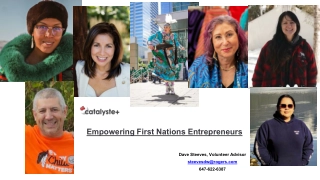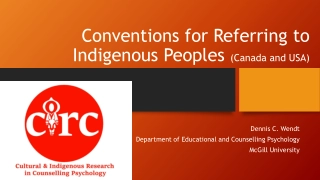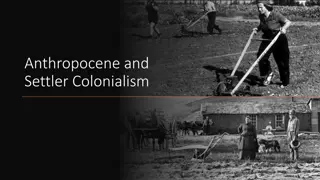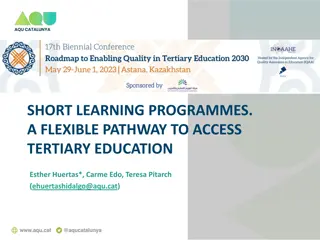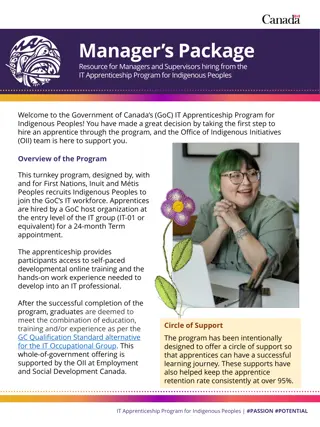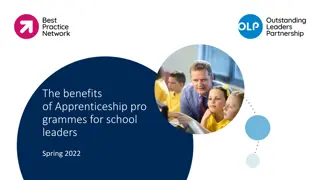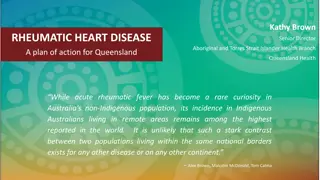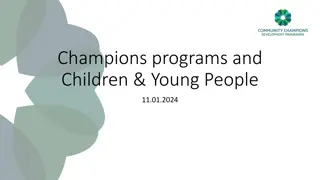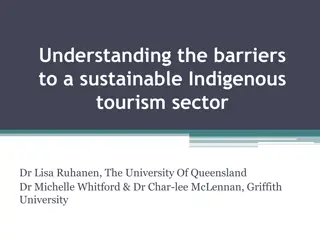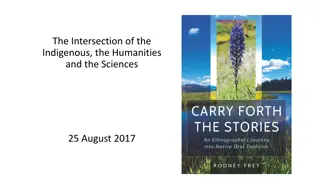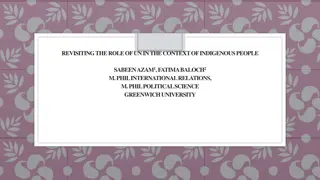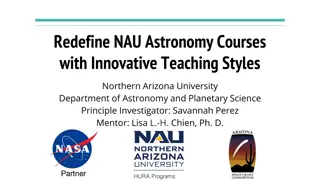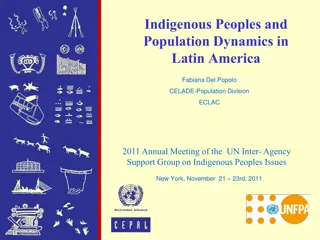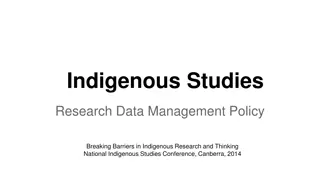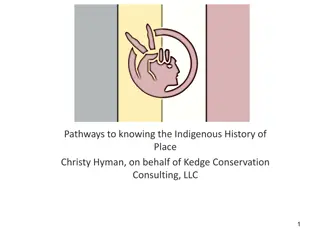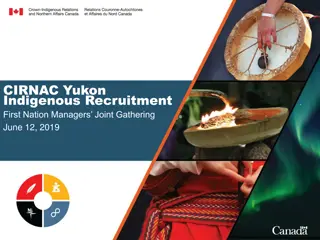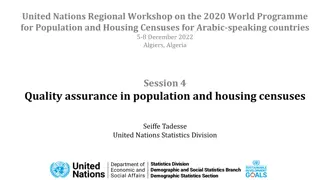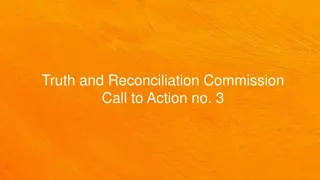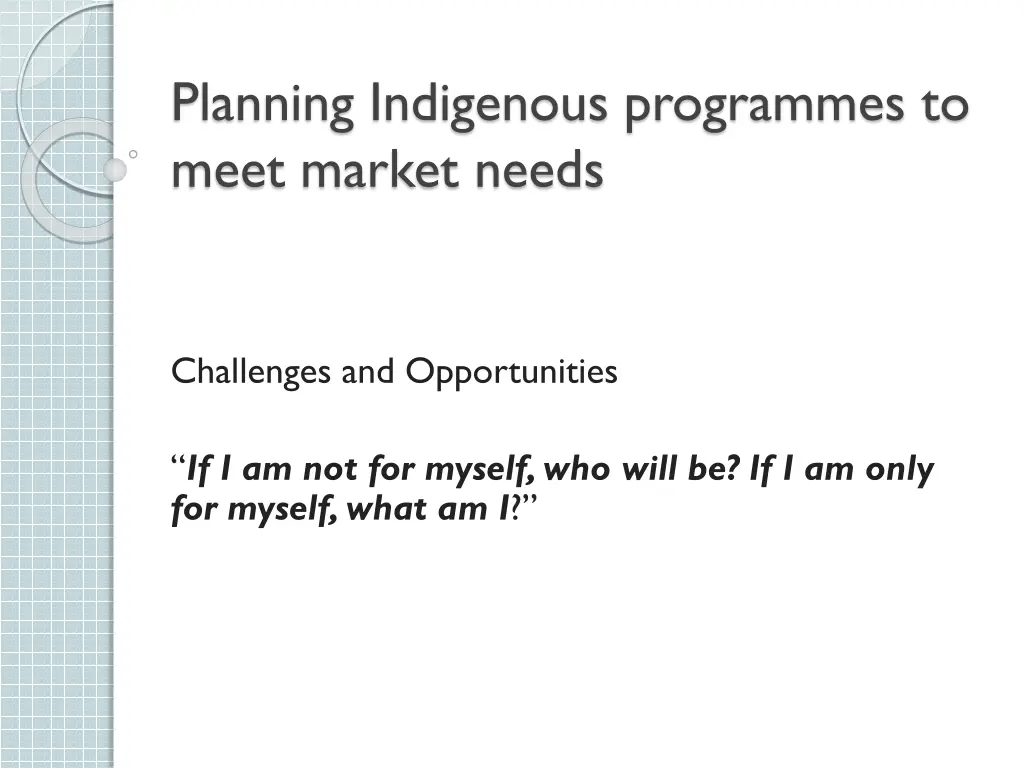
Challenges and Opportunities in Planning Indigenous Programmes to Meet Market Needs
Explore the challenges and opportunities in creating indigenous programmes tailored to market needs. Considerations include local stakeholder involvement, cultural relevance, and addressing skill shortages. Learn about developing rationale, design steps, challenges, and implementation preparations. Discover the importance of balancing local and global perspectives in programme design.
Download Presentation

Please find below an Image/Link to download the presentation.
The content on the website is provided AS IS for your information and personal use only. It may not be sold, licensed, or shared on other websites without obtaining consent from the author. If you encounter any issues during the download, it is possible that the publisher has removed the file from their server.
You are allowed to download the files provided on this website for personal or commercial use, subject to the condition that they are used lawfully. All files are the property of their respective owners.
The content on the website is provided AS IS for your information and personal use only. It may not be sold, licensed, or shared on other websites without obtaining consent from the author.
E N D
Presentation Transcript
Planning Indigenous programmes to meet market needs Challenges and Opportunities If I am not for myself, who will be? If I am only for myself, what am I?
STRUCTURE OF PRESENTATION Being indigenous Programme planning considerations Developing a rationale Design steps and challenges Preparing for implementation Opportunities Recommendations 14/06/2025 2
Indigenous programmes Developed by local stakeholders within local contexts; Having culturally relevant content; Connecting to the experiences of nationals; Responsive to local needs addressing critical skill shortages (e.g. cutters for fashion industry); supplying skilled graduates for key sectors of the T&T economy, and for administration and leadership; 14/06/2025 3
Designing programmes Rationale Objectives Content Learning experiences Evaluation Planning for implementation 14/06/2025 4
Rationale: Designing for myself, and for global contexts Challenge: Holding the tensions between the local and the global 14/06/2025 5
Powerful (seemingly opposed, but complementary) discourses drive the process We seek to create more indigenous programmes tailored to meet our national needs. (Karim, 2011, p.6) We are seeking to establish our presence on the world stage their accreditation status will ensure international recognition of our graduates as they seek further opportunities in our globalised economy. (Karim, 2011,pp. 9-10) 14/06/2025 6
The importance of the indigenous Affirming our sovereignty; Establishing national/regional identity; Setting our own agendas for development; Harnessing/cultivating our resources; Recognising that we can never compete with others on their terms; we have to carry any fight from our own turf. 14/06/2025 7
Being indigenous in Caribbean contexts: Who are we? Citizens of both our individual countries and the Caribbean region; Shared cultural experiences; Cultural experiences reflect an amalgam of different influences (being indigenous is being Creole ) Similarities in the developmental challenges facing our societies; Still in the process of understanding ourselves 14/06/2025 8
Nation building as rationale Why would our society invest in tertiary education on the scale that we have? TEIs have a critical role in supporting knowledge driven growth strategies and the construction of democratic, socially cohesive societies. (John Gardner p. 23) The norms, values, attitudes and ethics that TEIs impart to students are the foundation of social capital necessary for constructing healthy civil societies and cohesive cultures. ( Harrison & Huntington, 2000) 14/06/2025 9
Local context as rationale for indigenous programmes Social and economic patterns: High unemployment rates (and 55% for young people, according to 2012 Budget presentation) National stakeholder concerns: Chamber of Industry and Commerce s response to Budget 2012 speech establishes misalignment between labour needs and skills accessible ) Equity issues enhanced access & democratisation of education require planning for wide ability range; meeting specific student needs to ensure learning. 14/06/2025 10
Not being only for myself 14/06/2025 11
The tension between the global and the local: how the global dominates Providing employment to our nationals Influencing market trends Global education trends Technologies in the workplace 14/06/2025 12
Influence of globalisation on standards We are seeking to establish our presence on the world stage. (Karim 2011 p. 13): ACTT has accessed international standards in defining local criteria for accreditation Accreditation status will ensure international recognition of our graduates as they seek further opportunities in our globalised economy. (Karim 2011, pp. 9-10) 14/06/2025 13
Market Needs Lifelong learning NATIONAL/REGIONAL GLOBAL Evolving technologies Drivers of the national economy (e.g. tourism; creative industries e.g. fashion, film; agriculture, manufacturing, energy, science and technology, microenterprises; Advanced technologies Global drivers globalisation of markets; distribution of labour; membership in the knowledge society Preparation for civic life: governance; teacher education; leadership; administration Preparation for global citizenship: the knowledge, skills and attitudes to function beyond borders 14/06/2025 14
Market needs: Competencies to be developed Preparation for specific identified drivers of national economic and social development, e.g: tourism; manufacturing; the creative industries; agriculture; science and technology; administration and leadership Core skills and attitudes literacy, numeracy, information literacy; communicative competence; ethical decision making; sense of national and regional identity 21st century skills entrepreneurship, technical innovativeness, adaptability to changing environments and needs of production systems; collaboration; critical thinking and problem solving 14/06/2025 15
Challenge in deciding on content: Programme structure What to prioritise, and when: The local or the global? Focus on students developmental needs or employer needs? Which combinations of knowledge, skills and attitudes - for whom? (Response depends on your primary aims and philosophy) 14/06/2025 16
Emergent designs possibilities Responsive to individual personal and organisational developmental needs: Campus based Workplace based Multi-site; Modular; Transdisciplinary/Multi-disciplinary; Problem-centred 14/06/2025 17
Designing learning experiences to meet identified needs 14/06/2025 18
Learning as situated, collaborative, social 14/06/2025 19
Nature of learning as rationale: Sociocultural theories Learning: A continual process of constructing, interpreting, and modifying representations of reality based upon learners experience and negotiation of meaning with others . Students learn by immersing themselves in authentic problems and collaborating with others. Situating learning within authentic environments enculturates learners into the community of practice the community to which they aspire and within which they work. Lave (2010): Learning dependent on social context, cultural practices, conditions for application of learning etc. Learners bring their own cultural experiences and knowledge to learning events. 14/06/2025 20
Design challenge: providing environments to support learning Learning experiences to meet market needs demand student exposure to: different types of authentic social and organisational cultures; opportunities to address authentic problems; mentors, coaches to support learning 14/06/2025 21
Multiple sites/modes of learning Challenge: Optimal blend Campus based delivery basic theories and concepts, academic rigour, structured interactions; Work places authentic learning experiences, professional decision making opportunities, developing understanding of contexts and organisational structures; mentoring and coaching Virtual learning environments flexible learning opportunities, technologies bringing multiple contexts and professionals into classrooms, tools allowing simulations, extended opportunities for interaction, forming communities of practice 14/06/2025 22
Quality of learning provided in different environments Lochan (2003) identifies 5 models of entrepreneurial practice in T&T industries, some of which will not necessarily lead to social or economic transformation. All students not equally prepared to deal with virtual learning environments What sorts of preparation do our students need, to deal effectively with different learning environments? 14/06/2025 23
Assessment for learning ..the process of seeking and interpreting evidence for use by learners and their teachers to enable both to decide where learners are in their learning, where they need to go and how best to get there Students have the support they need for learning, and are motivated to achieve their own learning goals. (Assessment Reform Group, 2002) 14/06/2025 24
Challenges Absence, in some areas, of grounded understandings of organisational cultures, real models of entrepreneurship; Some institutions and departments have not developed a research culture to inform them about market needs, student abilities etc. Inadequate faculty and workplace skills to support process. 14/06/2025 25
Summary: What will indigenous program development entail? Identifying necessary competencies to meet market needs: specialised, technical knowledge and personal/interpersonal skills, values; Broad range of programme offerings and sites of learning; Collaborative design processes; Emergent designs to meet rapidly changing conditions; Transdisciplinary designs (working across traditional fields to deal with identified problems); Building bridges between campuses and multiple workplaces; Deciding on optimal sequences to facilitate learners construction and application of traditional disciplinary knowledge to solve authentic problems; Authentic learning opportunities inside and outside classrooms Assessment for learning as well as of learning 14/06/2025 26
Planning the logistics - challenges Collaborative planning Institutional support Human resources Funding 14/06/2025 27
Multiple relationships Sources of funding State Industry Students Within the Institution Community 14/06/2025 28
Collaborative design and stakeholder relationships The stakeholder relationship is assumed to consist of interactive, mutually engaged and responsive relationships that establish the very context of doing business, and create the groundwork for transparency and accountability. (Andriof et al. 2002: 9). This brings the notion of participation, dialogue and involvement to the centre of stakeholder theory Need for mutual goals, trust, conflict management, transparency, effective communication 14/06/2025 29
Challenges: Institutional support? Respect for stakeholders Structures to facilitate flexible arrangements Staff development opportunities Incentives for change Funding programmes 14/06/2025 30
Challenges of implementation Managing new types of working relationships; Constructing new understandings of expert knowledge ; New roles and responsibilities for staff, students and community; Less institutional control over learning environments; Juggling evolving processes and entrenched institutional structures Finding resources to support the process 14/06/2025 31
Maintaining quality across learning sites Establishing standards for: Off-campus learning environments Non-academic supervision Record keeping and communication Flexibility of standards to cover different arrangements. 14/06/2025 32
Opportunities Growth in international students choice of away- from-home programmes to prepare for global marketplace we can export programmes; Development of frameworks identifying needed competencies for different occupations Some industries willing (and financially able) to collaborate in developing programmes suited to market needs; Technologies make a range of authentic experiences (games, simulations) available 14/06/2025 33
RECOMMENDATIONS Identify clear criteria for assessing programme quality in different physical (non-campus) and virtual environments; Evidence-based programme planning decisions; More flexible institutional arrangements for programme planning and approval; Expanded role of mentorships, apprenticeships and internships within programmes; 14/06/2025 34
Recommendations (contd) TEI preparation of mentors, coaches for their tasks; Professional development of faculty for change: new roles, relationships and teaching and assessment strategies; Community/TEI projects and partnerships where town and gown borders disintegrate (e.g. community based co-curricular projects? Action research to meet industry and school needs?) Institutional collaboration to build knowledge base in different areas; 14/06/2025 35
Examples of useful research activities Developing grounded understandings about different organisational environments; Deeper understanding of dimensions of critical knowledge (of entrepreneurship, organisational competence, processes of ethical decision making etc.) related to local contexts; How construction of knowledge of these dimensions takes place in local contexts; Relationship management behaviours in TEI/Stakeholder relationships 14/06/2025 36
Thank you. 14/06/2025 37
Relationship management issues Negotiating goals; Building trust Maintaining effective communication Agreeing on shared purpose/s Managing conflict 14/06/2025 38

